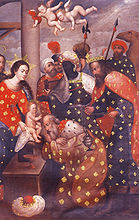- Cuzco School
-
 Virgin of Carmel Saving Souls in Purgatory, Circle of Diego Quispe Tito, 17th c., collection of the Brooklyn Museum
Virgin of Carmel Saving Souls in Purgatory, Circle of Diego Quispe Tito, 17th c., collection of the Brooklyn Museum
The Cuzco School (Escuela Cuzqueña) was a Roman Catholic artistic tradition based in Cusco, Peru (the former capital of the Inca Empire) during the Colonial period, in the 16th, 17th and 18th centuries. It was not limited to Cuzco only, but spread to other cities in the Andes, as well as to present day Bolivia and Ecuador.[1]
Contents
History
The tradition originated after the 1534 Spanish conquest of the Inca Empire,[1] and it is considered the first artistic center that systematically taught European artistic techniques in the Americas.[1]
The Cusqueña paintings were a form of religious art whose main purpose was didactic.[1] The Spanish, who aimed to convert the Incas to Catholicism, sent a group of religious artists to Cusco.[1] These artists formed a school for Quechua people and mestizos, teaching them drawing and oil painting.[1] The designation "Cusqueña," however, is not limited to the city of Cusco or to indigenous artists, as Spanish creoles participated in the tradition as well.
A major patron of the Cuzco artists was Bishop Manuel de Lollinedo y Angulo, who collected European art and made his collection available to Peruvian artists. He promoted and financially assisted such Cusqueña artists such as Basilio Santa Cruz Pumacallao, Antonio Sinchi Roca Inka, and Marcos Rivera.[2]
In 1688 Spanish-born and mestizo members of the Cuzco painting guild chose to break ranks with the Indian painters. This split led to the far more numerous Quechua Indian painters developing their own styles, based upon the latest European art works. They also created a tradition of painting Inca monarchs – a departure from Christian religious themes and an expression of cultural pride.[3]
Style
The defining characteristics of the Cusqueña style are believed to have originated in the art of Quechua painter Diego Quispe Tito.[4][5]
Cusqueña paintings are characterized by their use of exclusively religious subjects, their lack of perspective, and the predominance of red, yellow and earth colors.[1] They are also remarkable for their lavish use of gold leaf,[6] especially with images of the Virgin Mary. Though the Cusqueño painters were familiar with prints of Byzantine, Flemish and Italian Renaissance art, their works were freer than those of their European tutors; they used bright colors and distorted, dramatic images. They often adapted the topics to depict their native flora and fauna as a backdrop in their works.[1]
Warrior angels became a popular motif in Cusqueña paintings.[2]
Most Cusqueña paintings were created anonymously because of Pre-Columbian traditions that define art as communal.[1] An exception is one of the last members of the Cuzco School, Marcos Zapata (ca. 1710-1773). Other known artists of the Cuzco School include Diego Cusihuamán, Gregorio Gamarra, Basilio Santa Cruz Pumacallao, and Antonio Sinchi Roca Inka.
Collections
The largest collection of paintings from the Cuzco school is in the Cathedral of Santo Domingo (Cusco). The Lima Art Museum and the Inca Museum also house important collections.
A large number of works were destroyed in the 18th century so there is a limited supply of Cuzco school paintings. In recent years there has been a significant increase in demand from both Latin American art collectors and certain museums for paintings from the Cuzco school period.
Cuzco School artists
- Master of Calamarca, 18th c., Bolivia
- Basilio de Santa Cruz Pumacallao, 1635–1710, Peru
- Diego Quispe Tito, 1611—1681, Peru
- Marcos Zapata, ca. 1710—1773, Peru
See also
- Art of Latin America
- Art of Peru
- Native American art
- Latin American artists of indigenous descent
- List of indigenous artists of the Americas
- Indochristian art
Notes
References
- Bakewell, Peter J. A History of Latin America: C. 1450 to the Present. Blackwell Publishing, 2003. ISBN 0631231617.
- Bethell, Leslie. The Cambridge History of Latin America. Cambridge University Press, 1995. ISBN 0521245168.
- Fane, Diana, ed. Converging Cultures: Art & Identity in Spanish America. New York: Harry N. Abrams Inc., 1996. ISBN 0-87273-134-0.
External links
Categories:- Cusco School
- Peruvian art
- Bolivian art
- Indigenous painting of the Americas
- Mannerism
- Roman Catholic Church painting
Wikimedia Foundation. 2010.








